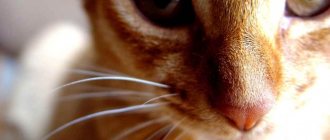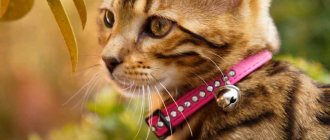The popular expression “they live like cats and dogs” usually implies hostility, however, the reality when it comes to domestic cats and dogs can be completely different. In fact, their peaceful coexistence under one roof is not only possible, but also easily feasible.
Dogs and cats are very different, but when they live in the wild, there are similarities in their lifestyle. Both species are quite antagonistic, although animals that have been socialized do not exhibit high levels of aggression.
Different languages of communication
When first meeting, dogs and cats can easily misunderstand each other's signals. For example, if a dog wags its tail, it means it is happy and playful, but a cat flicks its tail from side to side when it is angry.
What may be a friendly gesture from a dog can easily be perceived as aggression by a cat. For example, a dog wants to play, but the cat understands this as an invasion of its personal space and runs away. The dog loves to chase smaller animals and instinctively runs after the cat, not knowing that the cat does not like to be chased.
Dogs are not always the initiators of aggression. Often cats will confront them by arching their backs, hissing, or even hitting them with their paws with their claws fully extended. Some dogs may react to this behavior by becoming afraid of all cats.
Official theory
There are many more interesting myths and tales among the people about the reasons for mutual dislike between animals. But these are just fairy tales. People who study the habits of pets give more plausible explanations for the cause of hostility:
Different behavior. A cat and a dog are diametrically opposed creatures. The dog is a noisy creature that loves to run, bark, and frolic. Let your dog into an unfamiliar apartment, and he will immediately rush to explore and inspect the rooms.
And a calm, unperturbed adult cat prefers to lie more, looking around. She is characterized by innate isolation and indifference. Philosophers! But this behavior is typical of cats who are wise in life - young fluffies behave differently.
Curious dogs, wanting to get to know the cats, run towards them. Outraged by the shamelessness, the cats quickly run away, trying to scare off the impudent ones with their hissing and raised fur. This provokes the mischievous dogs even more – a fun chase begins.
Here we should also take into account the “Jewish” character of the purrs, who consider the place in which they live (a house, an apartment and even a street) to be their personal, inviolable property. The arrogance of dogs is immediately suppressed - cats aggressively defend their territory.
"Predatory" legacy. Dogs are driven to chase cats by an innate instinct that is transmitted genetically. Dogs are hunters by nature and will run after any moving object. Hunting habits intensify when the dog is outdoors. There is a similar, but diametrically opposed theory:
The wild ancestors of cats (lions, tigers, panthers, leopards) always pursued small relatives of dogs (hyenas, jackals, coyotes). The fear of big cats is ingrained in the subconscious of canines. Seeing the little purrs, the barking pets begin to take revenge. Instincts are awakened by the smell of a cat.
Unpleasant memories. Sometimes the kitty is quite peaceful and doesn’t mind playing with the dog. But the dog refuses the friendly relationship and snaps at the cat. This reaction is caused by unpleasant memories (a young dog was offended by a cat, scratching a curious person on the nose). The dog grew up, but the hostility and fear of purrs remained, fixed in the subconscious.
The owner's character. Owners of tailed pets are also capable of developing a hostile attitude towards cats. If a person is loyal to purrs, the dog, looking at him, will not show negative emotions.
But as soon as the owner demonstrates hostility towards felines, the dog duplicates human feelings. Enmity appears between pets.
This is interesting. Speaking about the difference in the behavior of animals, one curious feature was noticed - verbal contact. Dogs and cats have diametrically different body signals:
- A dog's tail wagging means interest and affection. In cats, tail movements indicate irritation or danger.
- When cats purr, they express pleasure. And the grumbling of dogs means a threat and a warning of an attack.
- If the dog raises his paw, he offers to play. The cat perceives this as a threatening action.
- Cat-like arching is a pose that signals an upcoming attack. And the dog, who does not understand this, reaches out to sniff the strange creature or lick it, getting hit in the face with a paw with sharp claws.
Animals perceive verbal signals differently. This is the source of misunderstanding. What to do?
Similarities in instinctive behavior
If cats or dogs lived in the wild, they would live in packs, where a similar order exists: there is an alpha animal, which is the leader of the community, and the rest of the individuals obey him. Ordinary members of the pack, usually females, hunt and bring food for their fellows.
In the wild, both cats and dogs are equally antagonistic. None of them are known to shy away from a fight. They will definitely protect their pack, cubs and food.
This behavior is very typical of wild relatives of domesticated cats and dogs. Watch any documentary about animals and you will notice this aggressive resemblance.
Dogs have been domesticated for a longer period of time than cats. In addition, they are very easy to train. To some extent, this allows dogs to better control their behavior.
At the same time, cats, which have been domesticated for centuries and even worshiped, continue to be alienated by nature. They have difficulty learning and cannot control their behavior to the same extent as domesticated dogs.
That was a long time ago…
And again about genetic memory. She seems to be the only explanation for the dog's eternal pursuit of the cat. Some childish question that excites the minds of adults and serious people, to which, apparently, there is no clear answer: “Why don’t dogs like cats?”
Some semblance of an adequate explanation can be found in the prehistoric period, when saber-toothed tigers (one of the most dangerous representatives of the cat family) walked the earth and brutally exterminated the canine family.
Dogs in those days were not distinguished by their gigantic sizes, they also did not have huge “saber” teeth, so many of them fell victims to ruthless “cats”, which were superior to dogs in size, sharpness of teeth, and cruelty.
And now, when the cats have “shrinked” to the size required by the dogs, they took a kind of carte blanche and considered themselves authorized to avenge the death of their ancient ancestors.
Why do cats and dogs fight?
Research has shown that moments of aggression that occur between cats and dogs who live together are normal animal behavior. Cats that are already accustomed to their canine siblings will still hiss, spit, and paw at them from time to time. Dogs will still follow their instincts and sometimes chase their feline companions.
Even with this sometimes provocative behavior, in homes where dogs and cats coexist, it is very rare that these animals can actually harm each other. But if a dog and a cat do not know each other and encounter each other outside their territory, for example, on the street, then they return to their innate wild animal instincts.
Remember all
Another reason why dogs don’t like cats is often the good memory that all dogs have. If a dog is quite belligerent against a cat, he angers and irritates it, which means that he has already experienced a bad experience of meeting a purring dog, in which the dog could have been injured (often cats, desperately defending themselves, deeply scratch the noses of curious dogs and injure the mucous membrane of the eyes).
How can a self-respecting dog forgive and forget this? There are no options here - for the pain and humiliation experienced, the dog will begin to take revenge on all the cats in a row.
Along the roads of fairy tales
A meeting between purrs and dogs is rarely peaceful. Hissing and snarling, the cat rushes to the saving tree, and the poor owner can hardly restrain the dog, inspired by yet another hatred. Legends are used to explain the reason for dog behavior.
Legend 1. Once upon a time dogs lived under water. They really wanted to look at the sun, the earth, and get to know the land inhabitants. Finally, the Supreme Deity allowed the dogs to stay on land, but gave this right for exactly a year.
The dogs, having come out onto the ground, gave the documents allowing them to return home to the cat. A year passed, the dogs, having thoroughly enjoyed life on land, decided to return to their native land. But the cat didn’t have any papers for a pass. All the documents were stolen by mice (according to the cunning cat).
Since then, the dogs have remained to live on earth and every time they meet a cat, they run after him, demanding the return of the papers. And cats hunt mice in the hope of taking away the dog's documents.
Legend 2. Once upon a time, there lived a little princess in a kingdom. The girl went for a walk without warning anyone and got into trouble. The little one, not noticing the deep hole, fell into it and began to cry. Hearing a desperate cry, a dog came to her aid. The dog pulled the princess out of the trap and took her to the palace.
The king generously rewarded the entire dog tribe. By order of the ruler, the inhabitants of the kingdom treated every dog entering the city and gave them shelter. The king sealed this order with the royal seal and attached it to the tail of the savior dog. The delighted dog hurried to her friend to share the good news.
The friends stayed up until dark, celebrating the award, and the dog had to stay overnight. To prevent the royal precious paper from becoming wrinkled, the decree was given for safekeeping to the cat who kept house in the house. The next morning the dog woke up and decided to hurry to notify all its relatives about the award. But the cat did not have the valuable document.
According to the furry cunning woman, the royal decree was stolen at night and chewed up by mice. The dog did not believe the cat and attacked her. It was from this moment that irreconcilable enmity was established between noble dogs and cunning cats. Thousands of years have passed since that moment, but the dogs still hope to find the precious decree.
As soon as the dog sees the cat, it rushes towards it, hoping that the paper has been found. And cats hunt mice, hating rodents for their gluttony.
Legend 3. Once upon a time, there lived a poor loser in the world. Things always went badly for him: the fish did not go into the net, the wheat did not grow in the fields, everything fell out of hand. Once, hoping to find mushrooms in the forest, the loser found a magic ring among the bushes. As soon as the poor man put it on his finger, things began to improve.
A poor man had a cunning cat. Noticing what changes were happening to the owner, the cat told his rich neighbor about everything. The rich man burst into the poor man's room and took the ring by force. The cat and the dog decided to help the unfortunate man and went to rescue the magic talisman.
They successfully stole the ring from the rich man and hurried home to please the owner. On the way, the tired dog fell asleep, and the cunning cat returned home on his own. The cat slandered the dog, telling the man that it was the dog who told the rich man about the find, and the smart cat returned the talisman.
The man got angry at the dog and kicked it out to live in the yard, starting to feed it scraps from the table. And he settled the insidious purr in the house. Now the cat has become a full-fledged mistress of the house, receiving care and love from the owner. Well, the dog harbored a grudge and since then every time he rushes to the cats to sort things out.
Legend 4. Once upon a time there lived a shepherd dog. He grazed mountain sheep high in the gorges. One day a storm began. A strong wind tore the warm hat off the dog's head and carried it away. The upset dog went to the furrier cat, taking a sheep skin for a new product.
The cat willingly accepted the order and took away the good quality material, promising that the new hat would be ready in a week, happily forgetting about her promise. After 7 days, the dog came for the order, but the cat begged him to wait another 3-4 days. The dog left, and the catman and his apprentices got to work. After a couple of days, the warm hat was ready.
Unfortunately, a rich goat-merchant came to the furrier to buy new furniture. Seeing the gorgeous hat, the goat immediately demanded to sell it, so we offered the cunning furrier a large sum of money. The greedy cat agreed to the deal and gave the merchant the dog's hat. Soon the dog came to get his thing.
The cat had no choice but to tell the dog that the hat was not ready. Enraged, the dog attacked the cat, calling the furrier a thief and a rogue. The poor dog was pushed out of the workshop. On the street, the dog saw a goat wearing his own hat and realized that the treacherous cat had deceived him.
Fear or avoidance
To say that an adult cat is afraid of a dog would not be entirely correct.
Despite the fact that the dog is larger and stronger, the cat has in its arsenal an equally formidable weapon that can cause significant damage.
A cat can always hide in a shelter that a large dog cannot fit into, or jump to a height that is insurmountable for him. And a cat driven into a corner is the most terrible animal, as the popular saying goes.
And in fact, such an animal looks terrifying - the cat turns sideways to the enemy, bristles the fur all over its body, arches its back and hisses threateningly. Even the biggest dogs freeze at the sight of such a monster! You can often observe how a cat, which is confident in its safety, seems to provoke the dog into aggressive actions. So, it is impossible to say unequivocally that a small fluffy, affectionate cat is mortally afraid of an angry huge dog - it all depends on the situation. And the cat tries to prevent a situation where the dog seriously wants to tear her apart.
Advantage of the Pack
The joint actions of social animals, which are canines, have many advantages over individualistic cats, who are forced to independently take care of their food and safety:
- A threat to singles . Despite caution and developed instincts, small and medium-sized cats in nature become frequent prey for canines. Thus, the young of the European forest cat are devoured by wolves, foxes and jackals, the slow-moving Pallas cats are successfully hunted by wolves, and the light-footed coyote easily catches up and kills stray cats. A lynx, although it weighs one and a half to two times less than a wolf, poses a serious danger in single combat with it. At the same time, wolves hunting in a pack surround the fleeing lynx, attack in a group and tear it to shreds. Hunters know that in places where there are a lot of wolves, “the lynx doesn’t stick around.” A seasoned lynx, scared from its resting place, flees from a pack of hunting dogs and can run up to 4-6 km before its strength begins to run out. The overtaken animal accurately assesses the situation and, being pursued by one dog, takes up a perimeter defense and fights on the ground. Moving away from the pack, the lynx uses a trivial cat trick and climbs a tree, hoping to sit there. If a shot from a hunter who arrives in time does not kill it outright, then a wounded cat falling down can seriously injure and even kill the dog, desperately clinging to life.
- Run, murka, run! The pack lifestyle allowed dogs to occupy a dominant position even in the conditions of the “concrete jungle,” forcing cats to habitually retreat. Undoubtedly, the difference in size plays a significant role, but even terriers weighing 5-8 kg frantically chase the neighbor's cats, feeling like they are the masters of the area. Thanks to its flexibility and maneuverability, the running cat demonstrates the skill of parkour, avoiding obstacles and climbing to a saving tree or other height inaccessible to the enemy. A single chase most often turns out to be fruitless, but a flock can push the cat away from the shelter and collectively work for destruction.











